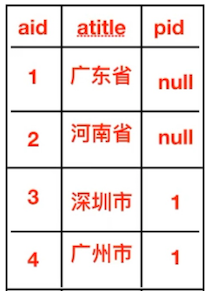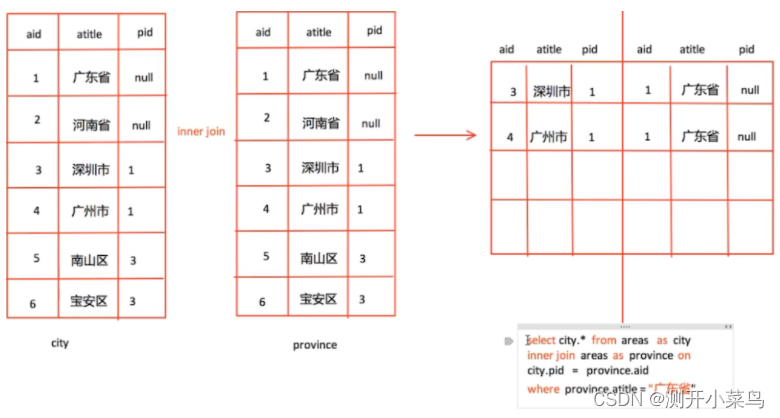数据库的分类
- 关系型数据库
- 非关系型数据库
关系型数据库:
是指采用了关系模型来组织数据的数据库,简单来说,关系模型指的就是二维表格模型,好比Excel文件中的表格,强调使用表格的方式存储数据。
关系型数据库中核心元素
- 数据行
- 数据列
- 数据表
- 数据库(数据表的集合)
常用的关系型数据库:
- Oracle
- Microsoft SQL Server
- MySQL
- SQLite
非关系型数据库:
非关系型数据库,又被称为NoSQL(Not Only SQL ),意为不仅仅是SQL,对NoSQL 最普遍的定义是“非关联型的”,强调 Key-Value 的方式存储数据。
常用的非关系型数据库:
- MongoDB
- Redis
数据类型和约束
数据类型
数据类型是指在创建表的时候为表中字段指定数据类型,只有数据符合类型要求才能存储起来,使用数据类型的原则是:够用就行,尽量使用取值范围小的,而不用大的,这样可以更多的节省存储空间。
常用数据类型如下:
- 整数:int,bit
- 小数:decimal
- 字符串:varchar,char
- 日期时间: date, time, datetime
- 枚举类型(enum)
数据类型说明:
- decimal表示浮点数,如 decimal(5, 2) 表示共存5位数,小数占 2 位.
- char表示固定长度的字符串,如char(3),如果填充’ab’时会补一个空格为’ab ',3表示字符数
- varchar表示可变长度的字符串,如varchar(3),填充’ab’时就会存储’ab’,3表示字符数
- 对于图片、音频、视频等文件,不存储在数据库中,而是上传到某个服务器上,然后在表中存储这个文件的保存路径.
- 字符串 text 表示存储大文本,当字符大于 4000 时推荐使用, 比如技术博客.
数据约束
约束是指数据在数据类型限定的基础上额外增加的要求.
常见的约束如下:
- 主键 primary key: 物理上存储的顺序. MySQL 建议所有表的主键字段都叫 id, 类型为 int unsigned.
- 非空 not null: 此字段不允许填写空值.
- 惟一 unique: 此字段的值不允许重复.
- 默认 default: 当不填写字段对应的值会使用默认值,如果填写时以填写为准.
- 外键 foreign key: 对关系字段进行约束, 当为关系字段填写值时, 会到关联的表中查询此值是否存在, 如果存在则填写成功, 如果不存在则填写失败并抛出异常.
数据类型附录表
整数类型
| 类型 | 字节大小 | 有符号范围(Signed) | 无符号范围(Unsigned) |
|---|---|---|---|
| TINYINT | 1 | -128 ~ 127 | 0 ~ 255 |
| SMALLINT | 2 | -32768 ~ 32767 | 0 ~ 65535 |
| MEDIUMINT | 3 | -8388608 ~ 8388607 | 0 ~ 16777215 |
| INT/INTEGER | 4 | -2147483648 ~2147483647 | 0 ~ 4294967295 |
| BIGINT | 8 | -9223372036854775808 ~ 9223372036854775807 | 0 ~ 18446744073709551615 |
字符串
| 类型 | 说明 | 使用场景 |
|---|---|---|
| CHAR | 固定长度,小型数据 | 身份证号、手机号、电话、密码 |
| VARCHAR | 可变长度,小型数据 | 姓名、地址、品牌、型号 |
| TEXT | 可变长度,字符个数大于 4000 | 存储小型文章或者新闻 |
| LONGTEXT | 可变长度, 极大型文本数据 | 存储极大型文本数据 |
| TINYINT | TINYINT | TINYINT |
时间类型
| 类型 | 字节大小 | 示例 |
|---|---|---|
| DATE | 4 | ‘2020-01-01’ |
| TIME | 3 | ‘12:29:59’ |
| DATETIME | 8 | ‘2020-01-01 12:29:59’ |
| YEAR | 1 | ‘2017’ |
| TIMESTAMP | 4 | ‘1970-01-01 00:00:01’ UTC ~ ‘2038-01-01 00:00:01’ UTC |
命令行客户端MySQL的使用
登录和登出数据库
登录数据库:
输入下面命令:
mysql -u用户名 -p密码
登录数据库效果图:

登录成功后, 输入如下命令查看效果:
# 显示当前时间
select now();
登出(退出)数据库:
quit 或 exit 或 ctrl + d
数据库操作的SQL语句
- 查看所有数据库
show databases;
- 创建数据库
create database 数据库名 charset=utf8;
- 使用数据库
use 数据库名;
- 查看当前使用的数据库
select database();
- 删除数据库(慎用)
drop database 数据库名;
表结构操作的SQL语句
- 查看当前数据库中所有表
show tables;
- 创建表
create table students(
id int unsigned primary key auto_increment not null,
name varchar(20) not null,
age tinyint unsigned default 0,
height decimal(5,2),
gender enum('男','女','人妖','保密')
);
说明:
create table 表名(
字段名称 数据类型 可选的约束条件,
column1 datatype contrai,
...
);
- 修改表-添加字段
alter table 表名 add 列名 类型 约束;
例:
alter table students add birthday datetime;
- 修改表-修改字段类型
alter table 表名 modify 列名 类型 约束;
例:
alter table students modify birthday date not null;
说明:
modify: 只能修改字段类型或者约束,不能修改字段名
- 修改表-修改字段名和字段类型
alter table 表名 change 原名 新名 类型及约束;
例:
alter table students change birthday birth datetime not null;
说明:
change: 既能对字段重命名又能修改字段类型还能修改约束
- 修改表-删除字段
alter table 表名 drop 列名;
- 查看创表SQL语句
show create table 表名;
- 查看创库SQL语句
show create database 数据库名;
- 删除表
drop table 表名;
表数据操作的SQL语句
- 查询数据
-- 1. 查询所有列
select * from 表名;
-- 2. 查询指定列
select 列1,列2,... from 表名;
- 添加数据
-- 1. 全列插入:值的顺序与表结构字段的顺序完全一一对应
insert into 表名 values (...)
例:
insert into students values(0, 'xx', default, default, '男');
-- 2. 部分列插入:值的顺序与给出的列顺序对应
insert into 表名 (列1,...) values(值1,...)
例:
insert into students(name, age) values('王二小', 15);
-- 3. 全列多行插入
insert into 表名 values(...),(...)...;
例:
insert into students values(0, '张飞', 55, 1.75, '男'),(0, '关羽', 58, 1.85, '男');
-- 4. 部分列多行插入
insert into 表名(列1,...) values(值1,...),(值1,...)...;
例:
insert into students(name, height) values('刘备', 1.75),('曹操', 1.6);
说明:
主键列是自动增长,但是在全列插入时需要占位,通常使用空值(0或者null或者default)
在全列插入时,如果字段列有默认值可以使用 default 来占位,插入后的数据就是之前设置的默认值
- 修改数据
update 表名 set 列1=值1,列2=值2... where 条件
例:
update students set age = 18, gender = '女' where id = 6;
- 删除数据
delete from 表名 where 条件
例:
delete from students where id=5;
问题:
上面的操作称之为物理删除,一旦删除就不容易恢复,我们可以使用逻辑删除的方式来解决这个问题。
-- 添加删除表示字段,0表示未删除 1表示删除
alter table students add isdelete bit default 0;
-- 逻辑删除数据
update students set isdelete = 1 where id = 8;
说明:
逻辑删除,本质就是修改操作
as和distinct关键字
as关键字
在使用SQL语句显示结果的时候,往往在屏幕显示的字段名并不具备良好的可读性,此时可以使用 as 给字段起一个别名。
使用 as 给字段起别名
select id as 序号, name as 名字, gender as 性别 from students;
可以通过 as 给表起别名
-- 如果是单表查询 可以省略表名
select id, name, gender from students;
-- 表名.字段名
select students.id,students.name,students.gender from students;
-- 可以通过 as 给表起别名
select s.id,s.name,s.gender from students as s;
说明:
在这里给表起别名看起来并没有什么意义,然而并不是这样的,我们在后期学习 自连接 的时候,必须要对表起别名。
distinct关键字
distinct可以去除重复数据行。
select distinct 列1,... from 表名;
例: 查询班级中学生的性别
select name, gender from students;
-- 看到了很多重复数据 想要对其中重复数据行进行去重操作可以使用 distinct
select distinct name, gender from students;
where条件查询
where条件查询的介绍
使用where条件查询可以对表中的数据进行筛选,条件成立的记录会出现在结果集中。
where条件查询语法格式如下:
select * from 表名 where 条件;
例:
select * from students where id = 1;
比较运算符查询
- 等于: =
- 大于: >
- 大于等于: >=
- 小于: <
- 小于等于: <=
- 不等于: != 或 <>
例1:查询编号大于3的学生:
select * from students where id > 3;
例2:查询编号不大于4的学生:
select * from students where id <= 4;
例3:查询姓名不是“黄蓉”的学生:
select * from students where name != '黄蓉';
例4:查询没被删除的学生:
select * from students where is_delete=0;
逻辑运算符查询
- and
- or
- not
例1:查询编号大于3的女同学:
select * from students where id > 3 and gender=0;
例2:查询编号小于4或没被删除的学生:
select * from students where id < 4 or is_delete=0;
例3:查询年龄不在10岁到15岁之间的学生:
select * from students where not (age >= 10 and age <= 15);
说明:
多个条件判断想要作为一个整体,可以结合‘()’。
模糊查询
- like是模糊查询关键字
- %表示任意多个任意字符
- _表示一个任意字符
例1:查询姓黄的学生:
select * from students where name like '黄%';
例2:查询姓黄并且“名”是一个字的学生:
select * from students where name like '黄_';
例3:查询姓黄或叫靖的学生:
select * from students where name like '黄%' or name like '%靖';
范围查询
- between … and … 表示在一个连续的范围内查询
- in 表示在一个非连续的范围内查询
例1:查询编号为3至8的学生:
select * from students where id between 3 and 8;
例2:查询编号不是3至8的男生:
select * from students where (not id between 3 and 8) and gender='男';
空判断查询
- 判断为空使用: is null
- 判断非空使用: is not null
例1:查询没有填写身高的学生:
select * from students where height is null;
注意:
- 不能使用 where height = null 判断为空
- 不能使用 where height != null 判断非空
- null 不等于 ‘’ 空字符串
排序
排序查询语法:
select * from 表名 order by 列1 asc|desc [,列2 asc|desc,...]
语法说明:
- 先按照列1进行排序,如果列1的值相同时,则按照 列2 排序,以此类推
- asc从小到大排列,即升序
- desc从大到小排序,即降序
- 默认按照列值从小到大排列(即asc关键字)
例1:查询未删除男生信息,按学号降序:
select * from students where gender=1 and is_delete=0 order by id desc;
例2:显示所有的学生信息,先按照年龄从大–>小排序,当年龄相同时 按照身高从高–>矮排序:
select * from students order by age desc,height desc;
分页查询
分页查询的语法
select * from 表名 limit start,count
说明:
- limit是分页查询关键字
- start表示开始行索引,默认是0
- count表示查询条数
例1:查询前3行男生信息:
select * from students where gender=1 limit 0,3;
简写
select * from students where gender=1 limit 3;
已知每页显示m条数据,求第n页显示的数据
提示: 关键是求每页的开始行索引
查询学生表,获取第n页数据的SQL语句:
select * from students limit (n-1)*m,m
聚合函数
常用的聚合函数
- count(col): 表示求指定列的总行数
- max(col): 表示求指定列的最大值
- min(col): 表示求指定列的最小值
- sum(col): 表示求指定列的和
- avg(col): 表示求指定列的平均值
求总行数
-- 返回非NULL数据的总行数.
select count(height) from students;
-- 返回总行数,包含null值记录;
select count(*) from students;
求最大值
-- 查询女生的编号最大值
select max(id) from students where gender = 2;
求最小值
-- 查询未删除的学生最小编号
select min(id) from students where is_delete = 0;
求和
-- 查询男生的总身高
select sum(height) from students where gender = 1;
-- 平均身高
select sum(height) / count(*) from students where gender = 1;
求平均值
-- 求男生的平均身高, 聚合函数不统计null值,平均身高有误
select avg(height) from students where gender = 1;
-- 求男生的平均身高, 包含身高是null的
select avg(ifnull(height,0)) from students where gender = 1;
说明
ifnull函数: 表示判断指定字段的值是否为null,如果为空使用自己提供的值。
聚合函数的特点
聚合函数默认忽略字段为null的记录 要想列值为null的记录也参与计算,必须使用ifnull函数对null值做替换。
分组查询
分组查询基本的语法格式
GROUP BY 列名 [HAVING 条件表达式] [WITH ROLLUP]
说明:
- 列名: 是指按照指定字段的值进行分组。
- HAVING 条件表达式: 用来过滤分组后的数据。
- WITH ROLLUP:在所有记录的最后加上一条记录,显示select查询时聚合函数的统计和计算结果
group by的使用
group by可用于单个字段分组,也可用于多个字段分组
-- 根据gender字段来分组
select gender from students group by gender;
-- 根据name和gender字段进行分组
select name, gender from students group by name, gender;
group by + group_concat()的使用
group_concat(字段名): 统计每个分组指定字段的信息集合,每个信息之间使用逗号进行分割
-- 根据gender字段进行分组, 查询gender字段和分组的name字段信息
select gender,group_concat(name) from students group by gender;
group by + 聚合函数的使用
-- 统计不同性别的人的平均年龄
select gender,avg(age) from students group by gender;
-- 统计不同性别的人的个数
select gender,count(*) from students group by gender;
group by + having的使用
having作用和where类似都是过滤数据的,但having是过滤分组数据的,只能用于group by
-- 根据gender字段进行分组,统计分组条数大于2的
select gender,count(*) from students group by gender having count(*)>2;
group by + with rollup的使用
with rollup的作用是:在最后记录后面新增一行,显示select查询时聚合函数的统计和计算结果
-- 根据gender字段进行分组,汇总总人数
select gender,count(*) from students group by gender with rollup;
-- 根据gender字段进行分组,汇总所有人的年龄
select gender,group_concat(age) from students group by gender with rollup;
多表查询
连接查询可以实现多个表的查询,当查询的字段数据来自不同的表就可以使用连接查询来完成。
内连接
查询两个表中符合条件的共有记录
内连接查询效果图:

内连接查询
内连接查询语法格式:
select 字段 from 表1 inner join 表2 on 表1.字段1 = 表2.字段2
说明:
- inner join 就是内连接查询关键字
- on 就是连接查询条件
例1:使用内连接查询学生表与班级表:
select * from students as s inner join classes as c on s.cls_id = c.id;
左连接
以左表为主根据条件查询右表数据,如果根据条件查询右表数据不存在使用null值填充
左连接查询效果图:

左连接查询语法格式:
select 字段 from 表1 left join 表2 on 表1.字段1 = 表2.字段2
说明:
- left join 就是左连接查询关键字
- on 就是连接查询条件
- 表1 是左表
- 表2 是右表
例1:使用左连接查询学生表与班级表:
select * from students as s left join classes as c on s.cls_id = c.id;
右连接
以右表为主根据条件查询左表数据,如果根据条件查询左表数据不存在使用null值填充
右连接查询效果图:

右连接查询语法格式:
select 字段 from 表1 right join 表2 on 表1.字段1 = 表2.字段2
说明:
- right join 就是右连接查询关键字
- on 就是连接查询条件
- 表1 是左表
- 表2 是右表
例1:使用右连接查询学生表与班级表:
select * from students as s right join classes as c on s.cls_id = c.id;
自连接
左表和右表是同一个表,根据连接查询条件查询两个表中的数据。
区域表效果图

例1:查询省的名称为“山西省”的所有城市

创建areas表:
create table areas(
id varchar(30) not null primary key,
title varchar(30),
pid varchar(30)
);
执行sql文件给areas表导入数据:
source areas.sql;
说明:
source 表示执行的sql文件
自连接查询的用法:
select c.id, c.title, c.pid, p.title from areas as c inner join areas as p on c.pid = p.id where p.title = '山西省';
说明:
自连接查询必须对表起别名
子查询
在一个 select 语句中,嵌入了另外一个 select 语句, 那么被嵌入的 select 语句称之为子查询语句,外部那个select语句则称为主查询.
主查询和子查询的关系:
- 子查询是嵌入到主查询中
- 子查询是辅助主查询的,要么充当条件,要么充当数据源
- 子查询是可以独立存在的语句,是一条完整的 select 语句
子查询的使用
例1. 查询大于平均年龄的学生:
select * from students where age > (select avg(age) from students);
例2. 查询学生在班的所有班级名字:
select name from classes where id in (select cls_id from students where cls_id is not null);
例3. 查找年龄最大,身高最高的学生:
select * from students where (age, height) = (select max(age), max(height) from students);